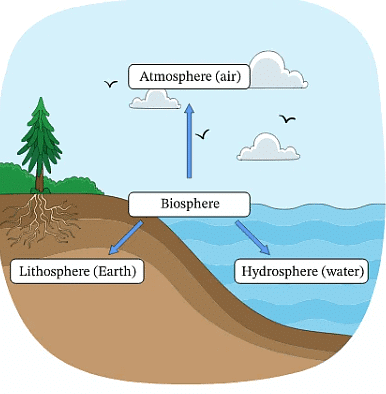Worksheet Solutions: Major Domains of the Earth - Class 6 PDF Download
Q: Answer the following Questions
(i) Explain the terms, Lithosphere, Atmosphere, Hydrosphere and Biosphere.
Ans:
- Lithosphere: The solid outermost layer of the Earth, composed of the crust and the upper part of the mantle. It includes continents, ocean floors, and various landforms.
- Atmosphere: The envelope of gases surrounding the Earth. It consists of layers of air that protect and interact with the planet's surface, playing a crucial role in climate and weather.
- Hydrosphere: The water component of the Earth, including oceans, seas, lakes, rivers, groundwater, and even water vapor in the atmosphere. It is essential for supporting life and shaping the planet's surface.
- Biosphere: The realm where living organisms exist. It encompasses all ecosystems and habitats where life is found, from deep oceans to high mountains, interacting with the lithosphere, atmosphere, and hydrosphere.

(ii) What are the two main divisions of the earth’s surface?
Ans: The two main divisions of the Earth's surface are the continents and the oceans.
(iii) Name the major continents of the earth. Write a short note on the seven major continents.
Ans: The seven major continents are Asia, Africa, North America, South America, Antarctica, Europe, and Australia. Each continent has unique geographical features, cultures, and ecosystems.
(iv) Why is the earth called the ‘blue planet’?
Ans: The Earth is called the 'blue planet' because when viewed from space, its surface is predominantly covered by water, giving it a bluish appearance.

(v) Why is the Biosphere important for living organisms?
Ans: The Biosphere is essential for living organisms as it provides habitats, resources, and interactions necessary for life to thrive. It supports biodiversity, regulates ecosystems, and ensures the availability of oxygen and nutrients.
(vi) The deepest point on the earth is _____________ in the Pacific Ocean.
Ans: The deepest point on Earth is the Mariana Trench in the Pacific Ocean.
(vii) Carbon dioxide (CO2) is considered an important constituent of air. Explain.
Ans: Carbon dioxide (CO2) is vital in the atmosphere as a greenhouse gas. It traps heat, maintaining Earth's temperature suitable for life. However, excess CO2 due to human activities contributes to global warming.
(viii) The atmosphere is divided into five layers based on composition, temperature and other properties. Name these layers.
Ans: The layers of Earth's atmosphere are the Troposphere, Stratosphere, Mesosphere, Thermosphere, and Exosphere. These layers vary in temperature, composition, and properties.
(ix) Why is Carbon Dioxide considered important?
Ans: Carbon dioxide (CO2) is important for photosynthesis in plants. However, excess CO2 from human activities contributes to global warming and climate change.
(x) What is termed Global Warming?
Ans: Global warming refers to the long-term increase in Earth's average surface temperature due to the buildup of greenhouse gases in the atmosphere, primarily caused by human activities like burning fossil fuels.
(xi) What are the four major domains of the earth?
Ans: The four major domains of the Earth are:
- Lithosphere: The solid outer layer comprising the Earth's crust and upper mantle.
- Hydrosphere: The water component of the Earth, including oceans, rivers, lakes, and groundwater.
- Atmosphere: The layer of gases surrounding the Earth, vital for life and weather systems.
- Biosphere: The zone where life exists, encompassing all living organisms and their interactions.
(xii) Write a short note on the Hydrosphere.
Ans: The hydrosphere is the Earth's water system, encompassing oceans, seas, lakes, rivers, glaciers, and groundwater. It plays a critical role in supporting life, regulating climate, and shaping the planet's surface through erosion and deposition processes.

(xiii) Name the two continents that lie entirely in the Southern Hemisphere.
Ans: The two continents entirely in the Southern Hemisphere are Antarctica and Australia.
(xiv) Why is the Northern Hemisphere called the Land Hemisphere?
Ans: The Northern Hemisphere is often referred to as the Land Hemisphere because it contains a larger portion of the Earth's landmass compared to the Southern Hemisphere.
(xv) The mountain range that separates Europe from Asia is the Urals. True or False?
Ans: False. The Urals do separate Europe from Asia, but they are not a continuous mountain range like the Himalayas. Instead, they are a more modest mountain system.
(xvi) Who were the first men to climb the highest mountain peak, Mt. Everest? Mention the date.
Ans: Sir Edmund Hillary from New Zealand and Tenzing Norgay, a Sherpa from Nepal, were the first to summit Mount Everest on May 29, 1953.
(xvii) Mention the five major Oceans in the order of their size.
Ans: The five major oceans, in order of size, are the Pacific Ocean, the Atlantic Ocean, the Indian Ocean, the Southern Ocean (or Antarctic Ocean), and the Arctic Ocean.
(xviii) What are the uses of Nitrogen and Oxygen gases?
Ans: Nitrogen is crucial for plant growth and is a major component of proteins. Oxygen supports cellular respiration, a process vital for releasing energy from food.
(xix) What makes the water from rivers unsuitable for human use?
Ans: Water from rivers can be polluted with contaminants like industrial waste and sewage, making it unsafe for direct human consumption without proper treatment.
(xx) Which are the Indian Research Stations of Antarctica? Name them.
Ans: The Indian Research Stations in Antarctica are named Maitri and Bharati.
FAQs on Worksheet Solutions: Major Domains of the Earth - Class 6
| 1. What are the major domains of the Earth? |  |
| 2. What is the lithosphere? |  |
| 3. What is the hydrosphere? |  |
| 4. What is the atmosphere? |  |
| 5. What is the biosphere? |  |



















